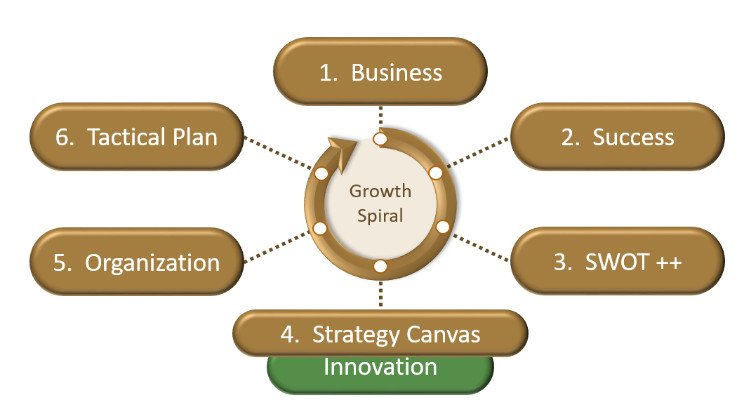Strategic Planning Recipe for Small business
Attention Entrepreneurs! Are you looking for a recipe to create a road-map?
Here are 6 steps to build a sustainable growth cycle that will also inspire your management. This is a result of close association in helping many of my business clients over the past few years.
STEP 1: Re-define Business
Question – Do Mission or Vision statements help with organization alignment?
Managers often believe that vision, mission and values are just for branding purpose. Leaders see them as messaging to align organization, define priorities, guide decision making, …really help focus.
Of course, many companies, would make statements typically defining customer satisfaction, employee engagement, world class product quality, etc.…. These typically indicate lack of effort on part of leadership to really define who they want to be perceived as. The trendsetters see themselves differently. They perceive their mission to be one that impacts society. For Example – “Develop Technologies that favorably impact 10 million lives” The moment you do that, your strategy naturally tends towards a competitive advantage, and the vision inspires employees.
Business evolves. Learning as you go, helps you redefine your purpose, your vision, and at times, even your values. And rightly so. Collectively agree upon what value are you delivering to the market place, how is the value created, and how you compete? If need be conduct a full enterprise wide value stream. It might be the best Selfie you take.
STEP 2: Re-define your business Success
Would you drive a car without a dashboard ?
A common practice is to track sales and profits as the only success metric, and isolated decisions to manage variation. Invariably that keeps business in a state of dynamic stability using up all reserves required to grow. This is when you hear, we are juggling too many balls to think of growth. To have a sustainable growth, you must look at delivery, quality, customer, and employee metrics as well. Most business owners have all the data required to manage, but do not look at them together as a dashboard to take decisions. So, the next significant step is to setup a Dashboard or a balanced score card of your business KPIs (Key performance indicators).
This is a simultaneous display of most important metrics, designed to compete for company resources and management attention. Once you define the KPIs, go back to the value stream and identify points where the data will be picked up; and go to the organization chart and define, which role by activity (not who by name) is accountable to control the business metric. Set up the leadership calendar to review the data every week/month for decision making and corrective actions, as well as tracking the progress.
If you extend this dashboard 3 to 5 years out in the future, you will have a balanced growth proforma that will inspire your team on all important aspects of the business and not just financial. So often business owners have a financial proforma without substantiating set of actions to achieve it.
Now define the growth metric. For example, increase sales by 5 times in 4 year. We could call it 5X4Y.
STEP 3: Re-visit SWOT Analysis, with rigor.
Every business leadership team brainstorms on SWOT (Strength, Weakness, Opportunity, Threat). However, true value comes when it is anchored around a few pillars, that help you think systematically.
SW: Start with the value stream outlined in step 1. Layout the activities that capture the flow of material, cash, and information through your company. Lean the process by removing all non-value-added activities with end customers, employees, and regulatory compliance in mind. Ensure that you capture more than 95% of activities in your company. Now look for Strengths & Weaknesses. If you like you can deeper to process level. Now look at it from your success criterion from perspective (step 2) and add to the list.
OT: Current market position shows light on Opportunities & Threats. Now add the impact of PESTEL trends to these. (Political, Economic, Social, Technical, Environmental, and Legal).
STEP 4: Build a FRESH Strategy Canvas
Are you ready for a facilitated offsite to build the strategic growth canvas, now?
Brainstorming is required; It is good when facilitated by an outsider expert in inspiring forward-looking conversation; and it is great when structured around the following discussion topics in this sequence:
(1) Organic, acquisition or hybrid growth options to achieve success defined in step 2.
(2) Market capture or white space opportunities to aligned with step 3.
(3) Competitive forces, threats, bench-marking, differentiators, and re-positioning.
(4) Additional activities/resources required for growth options, and possible sources.
(5) Sales channel expansion and additional marketing needs, for expansion.
(6) Pricing models and any opportunities or pressure for revisions.
(7) Scale up and acquisition costs.
(8) Market share and cost risks.
(9) Data tie up across growth options and growth proforma
This gives you the insight into your options and actions to accomplish the desired growth proforma. Some options would require a follow study such as competitive bench-marking or market analysis, to further define specific tasks.
STEP 5: Re-visit your Organization Structure
Are you structured for growth or just grew into your current structure?
Another common hold back comes from having an organization chart based on current staff skill set and working relationship or chemistry or just how it evolved, rather than flow of material and information as discussed above. To start with, forget the names, focus on activities only. Sketch your organization chart to handle activities as a part of the value stream. Now allocate existing staff to the activities, based on their competency. Make it scalable so that you can retain it for up to 3-5X growth, by simply adding capacity at functional levels and not having to add management overhead. Clarify the objectives, role, responsibility, and expectations. If you find gaps, which you will, then hire/place the best available person for the job and help him build the skill set. It is OK to have one name at multiple roles in the organization; it would eventually clear up when you grow.
STEP 6: Create an engaging Tactical Plan
How often have you failed to execute, in the past? Let’s be different this time.
By now you have a long list of possible items from step 4. Sit down again as a team, review and screen each item, prioritize, assign names, budget where required, and due dates. This is your implementation Strategic Planning with action items. You now have a road-map that is actionable, designed to deliver to growth proforma.
To hold management and leadership accountable, share your plan and progress with everyone in the company. Use discretion with sensitive financial or employee data when it comes to public display. Add tracking of progress on action items to your dashboard as % complete and assign that KPI to the CEO. Every month, during leadership meeting, review the open action items and drive closure. Make it a habit until it becomes second nature.
SELF Discovery Question and improvement opportunity
Q: How long does it take to build a solid road-map using these 6 steps? A: ~2 months
Q: Do you think, this is a “Do It Yourself” exercise? A: Even Patriots have a coach.
Q: What is holding you back? Resources, Time, Your Best Manager, or is it YOU

